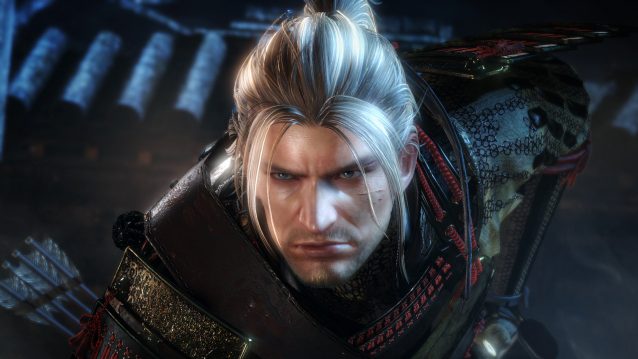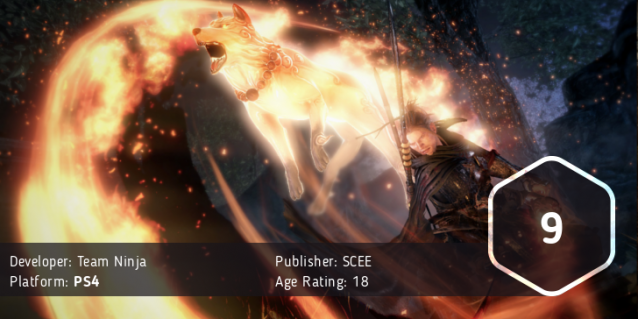Nioh is the modern equivalent of “like Dark Soul, but…”, so I’m going to try eschewing all mention of Dark Souls in this review (Ed: you’ve failed twice already) and try to review Nioh on its own merits. No more mention of Dark Souls (Ed: thrice). Let’s go back to the Sengoku period in Japan’s past to track down some demons.
Nioh sees you taking the heavily fictionalized part of William Adams, an English sailor who made his way to Japan at the opening of the 1600s. His real life is fascinating reading, and was the subject of the famous James Clavell novel, Shōgun. For Nioh, the similarity to the real character ends at his nationality and journey to Japan. William, it turns out, can communicate with spirits and see demons, and his arrival in Japan at the close of the Sengoku period (where the three warlords Oda Nobunaga, Tokugawa Ieyasu, and Toyotomi Hideyoshi unified Japan under a single Shogunate) sees William helping with the war effort by killing the oni and yokai (demons and spirits) that are terrifying and ravaging the countryside. Once again, the historical backdrop serves little but to add flavour to the game. Adams, for his part, is taken to serve Tokugawa Ieyasu, and he meets a fair number of people on his journey that were based on real personalities. If you have any interest in Eastern history, this game serves as a fantastic introduction to the people, despite its insanely loose interpretation of the actual events. Kotaku has a fascinating write-up on the real lives of the people featured in Nioh.
The game itself is an action, hack-n-slash affair very much in the style of a certain game that rhymes with Bark Coals (Ed: I’m counting that one). You’re provided a number of weapons in the game, from swords to axes to kusarigamas to long range weapons such as bows and rudimentary guns (bearing in mind that the main firearm, the tanegashima, was developed about a fifty years earlier, based on a 200 year old weapon by that point). Combat is notoriously difficult, and there are several mechanics that you have to end up balancing to be effective and efficient–just one or the other is not going to get you through the game. If you feel like adding an extra level of difficulty, you can summon the spirits of dead players to fight against you. They tend to have some nice gear on them, but they can definitely be a challenge, even at lower character levels.
The first mechanic is Ki, which translates, in this game, to stamina. Every action beyond simply blocking without being attacked or walking around your enemy consumes Ki. Attack too many times? You’re gonna have a bad time. Block too many attacks? You can “Ki’s” your energy goodbye. Dodge attacks? Take a breather. And of course, if you’re hit while winded, there’s a very big chance of dying. There’s a caveat, though: if you manage to tap R1 at the right time, you’ll perform a Ki Pulse, a move that not only restores a certain amount of Ki, but also dispels a funk cloud that Yokai love to leave around like a bad bout of intestinal gas. If you’re able to chain your attacks and dodges with well-timed Ki Pulses, you can press the attack and drain your opponent’s Ki instead, leaving them winded and unable to return the volley.
And then there’s Stance, which determines how much damage you take and give. High stance deals a lot, but you’ll get tons in return. High stace has an extra use in that you’ll easily break an enemy’s guard, but at your own peril. Low stance is defensive, meaning you’ll take less damage, but then you’ll do less as well. Mid stance is a balance between the two, but a wise warrior knows when to switch stances. Naturally, each stance uses a different amount of Ki, meaning you’ll have to switch back and forth depending on what you’re fighting and how that fight is going.
And then there’s the guardian spirit that you have attached to you. You initially start with one but as the game progresses, you’ll be able to obtain others and switch them out at save points. Guardian spirits have another meter that you can fill by defeating foes, and when it’s full you’ll be able to unleash a flurry of powerful attacks as long as your meter remains full. Taking damage drains the meter faster than the fuel gauge in a Bugatti Veyron going at full wobble.
Naturally, you’re going to die a lot in Nioh. Death and dying is, in itself, a mechanic in this game, and different creatures have different levels of permanence post-death. Unlike some brutal games where dying means losing just about everything you’re carrying, Nioh penalizes you only the unused experience points (called “Amrita” in this game) you’ve gathered up until that point, and the use of your guardian spirit. Once again, like a certain other game (Ed: I’m counting this one too. That’s five so far), reaching your grave site and touching the guardian spirit will restore you what you’ve lost. Die again before that point and you’ll lose the point permanently, but regain the use of your guardian spirit. If you’re going to play carelessly, expect to lose a lot of Amrita over the course of a game. You’ll learn very quickly to exercise the kind of caution you’d expect of a mouse sneaking past a cat’s noise.
Team Ninja takes some odd decisions with Nioh. For one, you’re only presented with any sort of tutorial after you’ve cleared the first stage and defeated the game’s first boss. Up until then, you’re left to figure it out on your own. There are two ways you can look at this: it’s either damned clever, allowing you to play with the game’s controls and mechanics before presenting you with the details of how to handle the finesses of the mechanics, thereby giving some kind of context to the tutorial; or it’s daft, making you muddle through a whole level before giving you some kind of instruction in how things work. I take the former view, but your mileage may vary.
Stage progression is via a glorified menu, showing a map and a selection of missions within each section. Your home base is Tokugawa Ieyasu’s mansion, which contains a shrine for upgrades, a blacksmith for mucking about with weapons, and a dojo for training and honing your skills. The dojo also serves as a set of tutorials if you wish to play them. The map screen is not a smooth exploration from stage to stage, but it serves the dual purpose of getting you from stage to stage safely, and giving you the option of multiple missions set within a particular stage. For example, once you’ve completed the second stage, set in a village, you can come back to it with a different set of circumstances and enemy layouts. Then there are the extra-hard optional missions you can play for extra reward, known as Twilight Missions.
The high difficulty level naturally can be a little on the frustrating side, and it seldom lets up. Just when you think you’ve got a grip on things the game can throw you a curveball, or you can sidestep just a little too late, or you can mistime your Ki Pulse by a second. And even if you’re at the point where you’re blazing through a level, you can never count on getting past a boss the first time around, since these guys are going to be some of the toughest sons of b…eaches that you’ll face in the game. The funny thing is that once you’ve figured things out, the second go around in the same level can be stupidly easy. I’ll give you an example: the first time I fought the boss of the second level, Onryoki, it took me several hours of dying and retrying. At the point where I was just about at the end of my tether and patience, something clicked and after a drawn out fight, I defeated the huge, lumbering thing. I decided, for the sake of understanding things, to replay that entire first level again, and I was able to finish the entire thing in one run. And then I went into the next level expecting to be able to blaze through it like I had my second playthrough of the previous level, and ended up dying very quickly. The game can be funny that way. You can make things easier by summoning another player to your game to help you. This does allow you to get through the more challenging bosses, but the game’s balancing doesn’t change, and the bosses can be made ridiculously easy with two of you attacking at once.
One of the interesting things that Nioh does is provide you with a number of graphical settings at the start, akin to the kinds of graphical options you’d see on a PC game. You can go for Movie mode, which is a stable 30fps mode with glorious HD graphics. Or you can spring for Action mode, which provides 60fps, but drops the game’s textures to handle the increased frame rate. And then there’s variable rate Movie mode, which gives you the high graphics resolution at frame rates between 30fps and…some undisclosed upper bound. On the PS4 Pro, you have even more options, allowing you to play the game in 4K as well, provided you have a compatible display. Which mode is better, of course, is a matter of opinion and personal preference.
Overall, I really, really enjoyed this game. I love the …other difficult game series (Ed: six), and the extra finesse involved in playing Nioh was a treat to play. There’s very little that’s wrong with the game, and very small niggles prevent it from being a perfect 10. Obviously, if you don’t enjoy ultra-difficult games, you’re not going to enjoy Nioh, but the sense of accomplishment upon getting through a particularly demanding section is so worth the frustration of dying over and over again.







